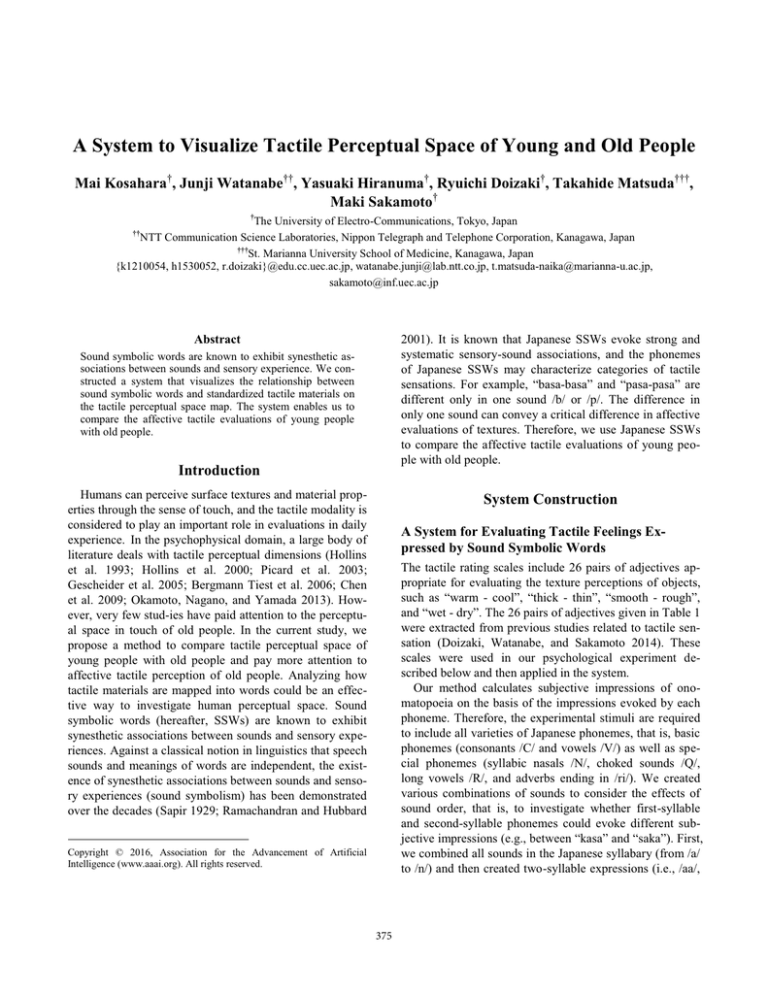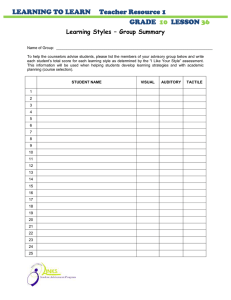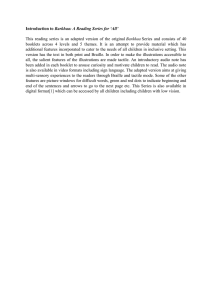
A System to Visualize Tactile Perceptual Space of Young and Old People
Mai Kosahara†, Junji Watanabe††, Yasuaki Hiranuma†, Ryuichi Doizaki†, Takahide Matsuda†††,
Maki Sakamoto†
†
The University of Electro-Communications, Tokyo, Japan
NTT Communication Science Laboratories, Nippon Telegraph and Telephone Corporation, Kanagawa, Japan
†††
St. Marianna University School of Medicine, Kanagawa, Japan
{k1210054, h1530052, r.doizaki}@edu.cc.uec.ac.jp, watanabe.junji@lab.ntt.co.jp, t.matsuda-naika@marianna-u.ac.jp,
sakamoto@inf.uec.ac.jp
††
2001). It is known that Japanese SSWs evoke strong and
systematic sensory-sound associations, and the phonemes
of Japanese SSWs may characterize categories of tactile
sensations. For example, “basa-basa” and “pasa-pasa” are
different only in one sound /b/ or /p/. The difference in
only one sound can convey a critical difference in affective
evaluations of textures. Therefore, we use Japanese SSWs
to compare the affective tactile evaluations of young people with old people.
Abstract
Sound symbolic words are known to exhibit synesthetic associations between sounds and sensory experience. We constructed a system that visualizes the relationship between
sound symbolic words and standardized tactile materials on
the tactile perceptual space map. The system enables us to
compare the affective tactile evaluations of young people
with old people.
Introduction
Humans can perceive surface textures and material properties through the sense of touch, and the tactile modality is
considered to play an important role in evaluations in daily
experience. In the psychophysical domain, a large body of
literature deals with tactile perceptual dimensions (Hollins
et al. 1993; Hollins et al. 2000; Picard et al. 2003;
Gescheider et al. 2005; Bergmann Tiest et al. 2006; Chen
et al. 2009; Okamoto, Nagano, and Yamada 2013). However, very few stud-ies have paid attention to the perceptual space in touch of old people. In the current study, we
propose a method to compare tactile perceptual space of
young people with old people and pay more attention to
affective tactile perception of old people. Analyzing how
tactile materials are mapped into words could be an effective way to investigate human perceptual space. Sound
symbolic words (hereafter, SSWs) are known to exhibit
synesthetic associations between sounds and sensory experiences. Against a classical notion in linguistics that speech
sounds and meanings of words are independent, the existence of synesthetic associations between sounds and sensory experiences (sound symbolism) has been demonstrated
over the decades (Sapir 1929; Ramachandran and Hubbard
System Construction
A System for Evaluating Tactile Feelings Expressed by Sound Symbolic Words
The tactile rating scales include 26 pairs of adjectives appropriate for evaluating the texture perceptions of objects,
such as “warm - cool”, “thick - thin”, “smooth - rough”,
and “wet - dry”. The 26 pairs of adjectives given in Table 1
were extracted from previous studies related to tactile sensation (Doizaki, Watanabe, and Sakamoto 2014). These
scales were used in our psychological experiment described below and then applied in the system.
Our method calculates subjective impressions of onomatopoeia on the basis of the impressions evoked by each
phoneme. Therefore, the experimental stimuli are required
to include all varieties of Japanese phonemes, that is, basic
phonemes (consonants /C/ and vowels /V/) as well as special phonemes (syllabic nasals /N/, choked sounds /Q/,
long vowels /R/, and adverbs ending in /ri/). We created
various combinations of sounds to consider the effects of
sound order, that is, to investigate whether first-syllable
and second-syllable phonemes could evoke different subjective impressions (e.g., between “kasa” and “saka”). First,
we combined all sounds in the Japanese syllabary (from /a/
to /n/) and then created two-syllable expressions (i.e., /aa/,
Copyright © 2016, Association for the Advancement of Artificial
Intelligence (www.aaai.org). All rights reserved.
375
/ai/, . . . , /wan/, /nn/). We obtained a total of 11,075 words,
including those made by repeating two-syllable onomatopoeic expressions (e.g., /aa-aa/, /ai-ai/). Moreover, we added 3,509 words with all types of special phonemes, such as
/fuwari/ and /peQtari/. Second, from these 14,584 words,
we selected 312 words that were judged by three participants as onomatopoeic expressions for describing texture
sensations. The selected 312 words used as stimuli covered
every possible kind of phoneme.
sions can be determined by the sound symbolism of each
expression, we created an impression-rating predictive
model according to the format below. The following equation can express the degree of impact, the type of consonants, and the presence or absence of voiced or semivoiced sounds, especially in regards to the impression created by the expression as a quantity. Furthermore, it will
provide a predictive value as a linear sum of the constituents.
warm - cool
thick - thin
easy - uneasy
good - bad
impressive - unimpressive
comfortable - uncomfortable
hard - soft
regular - irregular
clean - dirty
individual - typical
cheerful - gloomy
natural - artificial
friendly - unfriendly
X 1 X 2 X 3 X 11 X 12 X 13
the number of morae
Yˆ
Table 1. 26 Tactile rating scales
wet - dry
heavy - light
firm - fragile
slippery - sticky
sharp - dull
elastic - nonelastic
strong - weak
bumpy - flat
smooth - rough
stretch - nonstretch
intense - calm
luxury - cheap
repulsive- nonrepulsive
(1)
Where Yˆ represents a predictive rating value of onomatopoeia on a certain rating scale. X1 – X13 represent the category quantity (the degree of the impact each phoneme has
on the predictive rating value) for each phoneme. X1 – X6
respectively
represent
the
consonant
category,
voiced/semi-voiced, palatalized, lower case vowel, vowel
and medial indicator for the first mora, and X7 – X12 respectively represent the consonant category, voiced/semivoiced, palatalized, lower case vowel, vowel, and end of a
word indicator for the second mora (“mora” means a minimum size of a sound unit in Japanese). X13 represents the
presence or absence of repetitions. The detailed correspondences between variables and phonemes are shown in
Table 2.
Using the experimental stimuli, we conducted an impression-rating experiment (using the SD method) in which
we measured the actual value of the relationship between
phonological features and impression ratings to create a
quantitative rating database. The participants consisted of
78 native Japanese speakers aged 20 to 24 (51 males and
27 females) who were presented with onomatopoeic expressions that conveyed tactile feelings as well as tactile
rating scales for evaluation. Using a seven-point SD scale
(Very comfortable +3, Comfortable +2, Slightly comfortable +1, Neither 0, and three levels, -1 to -3, for uncomfortable feeling), the subjects responded in regard to what extent they felt each word related to each scale. The questionnaire form used in the experiment presented the stimuli
at random. Since the participants were divided into six
groups of 13, the calculations included 13 people per an
onomatopoeic expression. Thus, each participant gave their
impressions of about 52 onomatopoeic expressions chosen
from 312 expressions. They were unaware of the purpose
of the experiments, and they had no knowledge about linguistics. They were not trained to answer this type of questionnaire so that they simply answered intuitively their
impressions.
The experiment produced 105,456 items of data (26 rating scales × 312 expressions × 13 participants). Then, we
calculated the average rating value for each scale multiplied by each expression. On the basis of the hypothesis
that tactile feelings associated with onomatopoeic expres-
Table 2. Correspondences between Variables and Phonemes
First
mora
Second
mora
X1
X7
Phonological
characteristics
X3
X9
X4
X10
consonants
voiced
sounds /
p-sounds
contracted
sounds
vowels
X5
X11
semi-vowels
X6
X12
special sounds
X2
X8
X13
Phonemes
/k/, /s/, /t/, /n/, /h/,
/m/, /y/, /r/, /w/ or absence
presence or absence
presence or absence
/a/, /i/, /u/, /e/, /o/
/a/, /i/, /u/, /e/, /o/ or
absence
/N/, /Q/, /R/, /Li/ or
absence
presence or absence
repetition
Table 3. Examples of Category Quantities for Rating Scales
First mora
Rating scales Consonants
/k/
/t/
warm - cool
0.16
0.21
hard - soft
-0.82
-0.07
wet - dry
0.62
-0.74
slippery -0.19
0.04
sticky
-0.06
0.31
bumpy - flat
376
/h/
Voiced / psounds
voiced p -
-0.28
0.29
0.49
-0.18
0.13
0.18
-0.39
-0.46
0.62
-0.68
-0.13
0.48
-0.68
-0.15
-0.22
As shown in Table 3, the results of the quantification
theory I analysis include the average predictive rating value given to the category quantity for each scale. In addition,
the rating value for each onomatopoetic expression could
be determined by totaling the category values for each
phoneme in the expression. The multiple correlation coefficients R between the predicted values and average rating
values (actual values) were used as an indicator of prediction accuracy. As a result, for 20 scales, the R values were
in the range of 0.8 to 0.9, while for the other 6 scales, the R
values were 0.9 or higher. Therefore, we considered our
model to be sufficient for estimating onomatopoeia impressions to be evaluated by humans.
Using the above results, we constructed a system that estimates users’ tactile feelings expressed by input onomatopoeic words and quantitatively presents the estimated tactile feelings on the 26 tactile rating scales. Our system
comprises a user interface module, an onomatopoeia parsing module, and a database. Figures 1 and 2 show examples of the results output by our system. These examples
confirm that our system can evaluate the subtle difference
in characteristics of tactile feelings expressed by onomatopoeic words which are different in one phoneme “s” vs “z”.
Figure 1 shows that onomatopoeia “sara-sara” is strongly
associated with “thin”, “clean”, “dry”, “light”, “slippery”
and “nonelastic” feelings. On the other hand, Figure 2
shows that onomatopoeia “zara-zara” is strongly associated
with “impressive”, “hard”, “dry”, “nonelastic”, “rough”,
“nonstretch” and “intense” feelings.
Fig. 2. An evaluation result of onomatopoeia “zara-zara”
A System to Visualize Tactile Perceptual Space
First, we decided to use 43 SSWs shown in Table 4 to visualize tactile perceptual space (Sakamoto, Yoshino, and
Watanabe 2013). Sakamoto, Yoshino and Watanabe (2013)
selected 307 words that were judged by 3 experts as tactile
SSWs and confirmed that the selected 307 words covered
all kinds of Japanese phonemes. 307 SSWs were tested by
using Google search queries. Google search was conducted
on 6th July 2012 using Windows 8 Internet Explorer. Top
43 research results were selected as indexes to develop
tactile materials to cover major tactile sensation categories.
Table 4. 43 sound symbolic words
Fig. 1. An evaluation result of onomatopoeia “sara-sara”
377
sara-sara
tsuru-tsuru
kasa-kasa
syaka-syaka
puru-puru
syari-syari
sube-sube
fuwa-fuwa
gunya-gunya
puni-puni
peta-peta
gishi-gishi
zara-zara
gowa-gowa
kori-kori
butsu-butsu
beto-beto
jyori-jyori
gotsu-gotsu
mochi-mochi
boko-boko
pasa-pasa
nume-nume
tsubutsubu
poko-poko
beta-beta
funi-funi
puri-puri
zaku-zaku
syori-syori
moko-moko
fuka-fuka
kishi-kishi
fusa-fusa
sawa-sawa
mosa-mosa
gasa-gasa
nuru-nuru
chiku-chiku
mofu-mofu
funya-funya
suru-suru
howa-howa
Then, we have analyzed 43 SSWs by the system above.
Fig.3, Fig.4 and Fig.5 show the examples of evaluation
results of SSWs.
Fig.5 An evaluation result of onomatopoeia “puru-puru”
In our system, when a word expressing a tactile sensation intuitively is input into the text field, information
equivalent to evaluations against the sounds of the word.
Then we performed a principal component analysis using
the output of our system in the fundamental six tactile dimensions “hard - soft,” “rough - smooth,” “bumpy - flat,”
“sticky - slippery,” “wet - dry,” and “warm - cold” and
generated a distribution diagram of the SSWs using the
first and second principle components as the horizontal
axis and the vertical axis, respectively. In this diagram,
SSWs that express closely related sensations are also located close to each other on the map. Mapping the SSWs spatially enables us to visualize the categories of tactile sensations.
In order to visualize the standard relationship between
43 sound symbolic words and tactile materials, we have
decided to use the 50 standardized tactile materials developed by Sakamoto, Yoshino and Watanabe (2013), which
are materials uniquely associated with 43 SSWs. Finally,
we succeeded in visualizing the relationship between 43
SSWs and 50 tactile materials on a kind of tactile perceptual space map. The distribution map shows how tactile
sensations are categorized by young people. Although
mapping the SSWs spatially enables us to visualize the
categories of tactile sensations, the categories of tactile
sensations might be different among individuals, for example between young and old people, males and females,
different cultural backgrounds. Therefore, we constructed a
system that enables us to move SSWs to appropriate locations on the distribution map. When users move only a few
Fig.3 An evaluation result of onomatopoeia “kasa-kasa”
Fig.4 An evaluation result of onomatopoeia “gowa-gowa”
378
SSWs towards materials to be expressed by the SSWs, the
system automatically visualizes their tactile perceptual
space. The following is the algorithm to control movement
of SSWs.
When word A is moved, word B is influenced by word
A and moved. The following equation is used to calculate
the influence.
bution map appropriate for individual tactile perceptual
space. We can compare tactile sensations among individuals by comparing the maps. Therefore, we propose this
system to compare the affective tactile evaluations of
young people with old people.
(2)
In this paper, we proposed a method to compare tactile
perceptual space of young people with old people and contributed to pay more attention to affective tactile perception
of old people. In our future work, we aim to use this system to recommend tactile product materials appropriate for
each consumer’s perceptual tendency.
Conclusion
This equation is based on Gaussian function, and an elementary function of Gaussian function is used as “gravitation” in this equation.
In our system, a moved SSW can be fixed when its location fits user’s affective tactile evaluation. When word C
has been fixed and word A is moved, word B is influenced
by word A and word C. The following equation is used to
calculate the influence of word C.
Acknowledgements
This work was supported by a Grant-in-Aid for Scientific
Research on Innovative Areas “Tagenshitukanchi” (No.
15H05922) and Grant-in-Aid for Scientific Research(A)
and (B) (No. 15H01720 and 15H02766) from MEXT, Japan.
(3)
As the same as (2), this equation is based on Gaussian
function, and an elementary function of Gaussian function
is used as “gravitation” in this equation.
Our system comprises a user interface module, analyzing module and a database. When a user moves a SSW on
the map, the analyzing module calculates the influence of
the word according to (2), (3) and the database. Then, the
other sound symbolic words on the map are moved according to the influences.
References
Bergmann Tiest, W. M.; and Kappers, A. M. L. 2006. Analysis of
haptic perception of materials by multidimensional scaling and
physical measurements of roughness and compressibility. Acta
Psychologica 121(1): 1-20.
Chen, X.; Shao, F.; Barnes, C.; Childs, T.; and Henson, B. 2009.
Exploring relationships between touch perception and surface
physical properties. International Journal of Design 3(2): 67-77.
Doizaki, R., Watanabe, J., and Sakamoto, M. 2014. A System for
Evaluating Tactile Feelings Expressed by Sound Symbolic Words.
M. Auvray and C. Duriez (Eds.): In EuroHaptics 2014 Proceedings Part I, LNCS 8618, 32-39. Springer, Heidelberg.
Gescheider, G. A.; Bolanowski, S. J.; Greenfield, T. C.; and Brunette, K. E. 2005. Perception of the tactile texture of raised-dot
patterns: A multidimensional analysis. Somatosensory and Motor
Research 22(3): 127-140.
Hollins, M.; Faldowski, R.; Rao, S.; and Young, F. 1993. Perceptual dimensions of tactile surface texture: A multidimensional
scaling analysis. Perception & Psychophysics 54(6): 697-705.
Hollins, M.; Bensmaïa, S.; Karlof, K.; and Young, F. 2000. Individual differences in perceptual space for tactile textures: Evidence from multidimensional scaling. Perception & Psychophysics 62(8): 1534-1544.
Okamoto, S.; Nagano, H.; and Yamada, Y. 2013. Psychophysical
Dimensions of Tactile Perception of Textures. IEEE Transaction
on Haptics 6(1): 81-93.
Picard, D.; Dacremont, C.; Valentin, D.; and Giboreau, A. 2003.
Perceptual dimensions of tactile textures. Acta Psychologica
114(2): 165-184.
Ramachandran, V.S.; and Hubbard, E.M. 2001. Synesthesia – A
window into perception, thought, and language. Journal of Consciousness Studies 8(12): 3–34.
Fig. 6 State of a change of the distribution map.
Fig. 6 shows a state of a change of the distribution map.
In Fig. 6, the sound symbolic words are moved to the left.
As shown in Fig. 3, this system can make a different distri-
379
Sakamoto, M., Yoshino, J., and Watanabe, J. 2013. Development
of Tactile Materials Representing Human Basic Tactile Sensations. In Proceedings of the fifth International Congress of International Association of Societies of Design Research (IASDR
2013), 1068-1074. Shibaura Institute of Technology, Tokyo.
Sapir, E. 1929. A study in phonetic symbolism. Journal of Experimental Psychology 12(3): 225-239.
380




